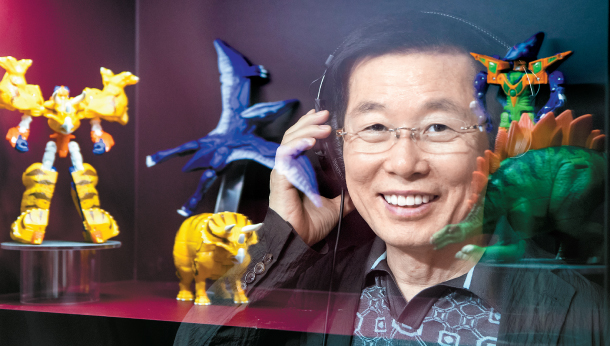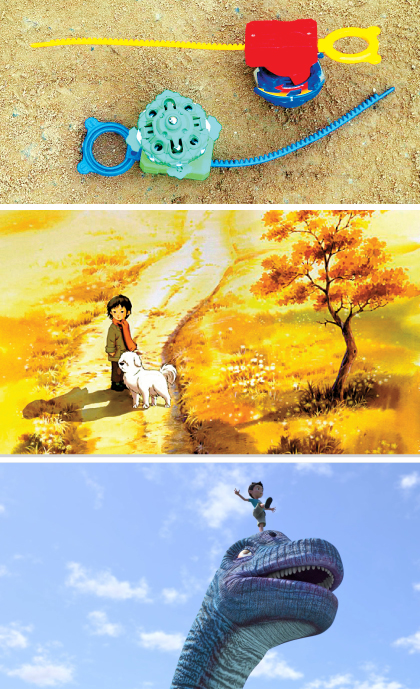The endlessly creative mind of Choi Shin-kyu : The director of ‘Hello Carbot the Movie: The Cretaceous Period’ believes the future of the Korean animation industry is bright

Choi Shin-kyu, 62, is an aspiring creator who is behind a variety of animated films and successful toys. The founder of animation and toy company Sonokong recently directed the first feature film of the popular animated series “Hello Carbot.” [JOONGANG PHOTO]
Though foreign films still make up most of the animated options at movie theaters in Korea, the success of several local releases, such as “Turning Mecard” and “Sophie Ruby,” is proof that the local animated film industry has the potential to stand next to some of the major global players.
“Hello Carbot” centers on an elementary school boy and a robot that transforms into a car. Starting off as a KBS television series in 2014, “Hello Carbot” has run six seasons. Thanks to its popularity, the show was turned into a feature film and was released on Aug. 1. “Hello Carbot the Movie: The Cretaceous Period” has held its own in the box office, performing well amid the fierce competition of the summer movie season.
Pitted against strong animated contenders like Disney-Pixar’s “Incredibles 2” and the popular Japanese animation “Detective Conan: Zero the Enforcer,” “Hello Carbot” has sold more than 850,000 tickets as of Monday.
Equally as surprising as the animated feature’s box office performance is the success of the person behind the series: 62-year-old animation and toy company founder Choi Shin-kyu. From Choi’s creative mind comes the exciting story of time travel and dinosaurs that transform into robots.
His achievement isn’t that surprising once one considers his background, which involves investing in and producing nearly 30 animated films, such as “Yonggary” (1999) and “White Heart Baekgu” (2000), as well as being a leader in the domestic toy industry.
In 2001, Choi introduced a toy named Top Blade, which spins like a top after the user pulls a string attached to it. He was also behind 2014’s Turning Mecard, a successful toy car that transforms into a robot when it touches an electronic card.
“I always think about children and live with children’s toys,” said Choi during an interview with JoongAng Ilbo, an affiliate of Korea JoongAng Daily.
“Whenever I have time, I walk around the stationery stores near elementary schools and observe the kids I see at stores to find out what they like. Frankly, adults don’t really understand children because kids see the world from their [unique] perspective.”
The following are edited excerpts from the interview.

Top Blades, top, introduced by Choi Shin-kyu in 2001, were some of the most popular toys of their time. A scene, middle, from the 2003 animated feature “Oseam,” which Choi invested in. Above, a scene from “Hello Carbot the Movie: the Cretaceous Period,” Choi’s directorial debut. [JOONGANG PHOTO, NEXT ENTERTAINMENT WORLD]
A. What I mean by that is returning every bit of knowledge and ability I have accumulated [as a member of] society. That’s the reason I decided to step down from running a business and become a creator. This film is my first work as a creator.
Is that the reason you call yourself a general director?
It has been almost 20 years since I worked on animated television shows like “White Heart Baekgu.” So far, I’ve planned and produced around 30 animated projects. I invested in films like “Yonggary” and “Oseam” (2003). I worked in the toy production and distribution industry for longer than 30 years, and also branched out to character goods and online games. I want to make a unique content native to Korea based on the diverse attempts I have made. [For “Hello Carbot the Movie: the Cretaceous Period”], I managed everything from music to images and CGI, just like an orchestra conductor.
You only studied until third grade of elementary school. How have you been able to achieve such success?
My father passed away when I was three, and my mother raised five children by selling goods on the streets. Naturally, I couldn’t finish school. At the age of 10, I acquired craftsmanship techniques at a jewelry shop located in Yeongdeungpo District [in western Seoul], [where I worked for] three years. After that, I went to work for a foundry. When I turned 19, my brother and I opened a foundry and made faucets. I got to work closer with children in 1983 after receiving a request from an acquaintance to make an automatic vending machine for toys.
You don’t sound like you had many toys to play with when you were a child. What did you play with?
All I had were few marbles and ttakji [folded paper]. Back then, I mostly played with used batteries from the radio and also used my imagination by making cars, trains and planes. I guess my mental age stopped at that happy time when I was a third grader.
What do you think led you to today’s success?
In the mid-1980’s, a simple sticky toy was a mega hit. When you threw it, it stuck to the wall and slowly wiggled its way down. That is what I regard to be my first invention. I think I sold around 30 million of them.
After your first invention, you were on a roll, right?
My other hit is [what I call] the popcorn toy, which pops when you flip it. Around 13 million were sold. [By then], I realized the importance of creativity. In the 2000s, I lost billions of won after investing in online games and IT toys. But I didn’t feel discouraged. I didn’t lose confidence because money comes and goes. I already experienced the lowest point of poverty in my childhood. It wasn’t possible for me to get worse than that.
You possess excellent business acumen. What’s your secret?
I didn’t graduate elementary school, so I wasn’t accepted anywhere. That’s why I had to become a CEO (laughs). I always deliberated and studied. My life motto is ‘There’s no success in lifetime.’ People with a lot [of wealth] feel a great sense of loss when they lose even just a little, but people who grew up without having much don’t get easily discouraged. Even if you fall, there’s always a way to get back up. [Success] is a matter of creativity and imagination.
Is that what inspired you to start working on content?
Thus far, I’ve made around 1,000 types of toys, including dolls and robots. The only way to survive now is to pivot. Some people think that I work in animation to sell more toys, but that’s not the case. If you introduce excellent products or content, money follows. Money shouldn’t be the purpose.
Do you dream of becoming Korea’s Marvel or Disney?
Yes I do. I will make investments thinking about 20 and 30 years in the future. I’m preparing the second “Hello Carbot” film and also a “Dinosaur Mecard” movie. Though the series are currently aimed at children, I hope to expand them to cater to families. I will pave the way for those younger than me who take this career path. Even I, someone without much education, have come this far. I believe they will be able to achieve something even bigger.
It definitely isn’t an easy career path.
The Korean film industry has seen a rapid growth in a short amount of time. The movie “Swiri,” which was released 20 years ago, was the catalyst to firmly establishing the industry. Even K-pop has become internationally popular. The same applies to animation. It has great potential.
There are concerns that the falling birth rate will shrink the size of the animation market. But there is a solution. If we encounter this problem, we can enter the African market, where the birth rate is relatively high. What matters more is to develop the ability to understand children’s feelings.
You remind me of Tom Hanks’ character from the 1998 film, “Big.”
Yes, I saw that movie, about a child who succeeds at creating a toy he wants. There is an answer in that film. Toys aren’t education. If you try to push an educational message through toys, children get sick of it. The most important thing that [a toy] needs to do is provide children joy. My role model is Geppetto, the [puppet maker] from “The Adventures of Pinocchio.” Geppetto made his masterpiece, Pinocchio, in the later years of his life. My Pinocchio hasn’t been created yet. Until then, I will continue making, again and again.
Director tries out composing
The young protagonist in “Hello Carbot the Movie: The Cretaceous Period” travels back in time to a world that looks nothing like his own.
In the new environment, the boy greatly misses his mother, and cries throughout the night. The soundtrack of the film features two songs, the titles of which translate to “Mother’s Face” and “Let’s Go See Dinosaurs.” Through these songs, the movie appeals to children’s emotions.
Behind the heartwarming soundtrack is the film’s director Choi Shin-kyu, who composed the songs and wrote the lyrics.
During the interview, Shin boasted that he had completed 40 songs during his spare moments while working on the film.
“There would probably be hundreds of songs if I included all of the ones that I haven’t recorded,” said Shin with a laugh.
Choi’s short-lived dream to become a singer in his youth is the force behind his passion for the song writing.
In the 1970s, when playing the acoustic guitar was in vogue, Shin taught himself how to play, as well as learning a little piano. After he started earning more stable income, Choi learned to sing and write songs from a professional songwriter.
“I knew I wasn’t good at singing,” said Choi. “So instead, I focused on composing and songwriting because it seemed doable for me. Day and night, I wrote everything down. These days, you can do pretty much everything on a computer. Though I’m not a professional, it doesn’t matter as long as I enjoy doing it. Even in the future, I plan to work on the music for the animations I make.”
By PARK JUNG-HO [jin.minji@joongang.co.kr]










with the Korea JoongAng Daily
To write comments, please log in to one of the accounts.
Standards Board Policy (0/250자)